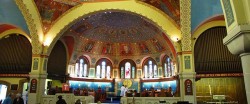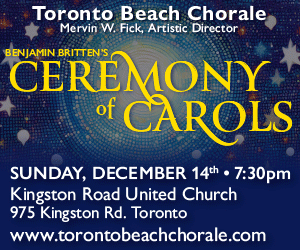 St. Anne’s Anglican Church is a beautiful, welcoming environment in which to hear a performance. Entering the church on Sunday, May 28, I was greeted with an exhibition of Indigenous artists, on the theme of reconciliation. The first piece I noticed was a striking silk dress with a subtly integrated traditional star quilt pattern created by designer and artist Sage Paul. Placed about the auditorium are other works of art, including paintings and a beautiful birch bark canoe. Beyond that, in front of the altar, the Evergreen Club Contemporary Gamelan (ECCG) was assembled to add its musical voice to the conversation.
St. Anne’s Anglican Church is a beautiful, welcoming environment in which to hear a performance. Entering the church on Sunday, May 28, I was greeted with an exhibition of Indigenous artists, on the theme of reconciliation. The first piece I noticed was a striking silk dress with a subtly integrated traditional star quilt pattern created by designer and artist Sage Paul. Placed about the auditorium are other works of art, including paintings and a beautiful birch bark canoe. Beyond that, in front of the altar, the Evergreen Club Contemporary Gamelan (ECCG) was assembled to add its musical voice to the conversation.
St. Anne’s ensemble-in-residence, the Junction Trio, opened the concert – titled “Post-Industrial Gamelan!” – with a Haydn divertimento, and the St. Anne’s Choir further quieted the mood with Tallis’ If Ye Love Me, Mozart’s Ave Verum Corpus, and Canadian composer Rupert Lang’s Kontakion.
After the release of two new recordings recently, the ECCG returned to more familiar territory for this performance. They began their portion of the set with a staple of the group’s repertoire, Anjeun (you), by the late Indonesian composer Nano Suratno. The piece was a pop hit in Indonesia in the 90s, but is a much subtler composition than any of the pop versions would have you believe, and is also a great introduction to the degung orchestra (and the ECCG is first and foremost that).
Rengga Renggi by Burhan Sukarma (arranged by ECCG member Bill Parsons) featured a lively section of “trading fours” between hand drums and other percussion, an energetic highlight of the performance.
Another mainstay of the ECCG repertoire, Lou Harrison’s Ibu Trish, a gently contemplative piece, was well suited to the ambience of the room. Canadian film composer Paul Intson’s Rainforest rounded out the program as the least traditional-sounding piece, full of melodic and rhythmic twists and turns, and fully utilizing the timbral possibilities in the gamelan.
The ECCG’s part of the program came to a close with a loosely-structured vehicle for joint improvisation between the gamelan and the Junction Trio. No one really took any risks, but the tremolos and long tones made for a gentle landing at the end of the program. In all, a subtly diverse set of compositions played with a relaxed familiarity, giving evidence to the ECCG’s long history of working together.
I feel compelled to commend St. Anne’s for its annual series of diverse programming, and even more so for its series of events on the theme of reconciliation (the current art exhibit but one of many this year). The concert performance of the ECCG, Junction Trio and St. Anne's Choir proved a powerful example of the diversity of music on offer at this venue. And as for the art exhibit that set the tone for afternoon, I was reminded, first, of the systematic persecution of local Indigenous communities, and second, of the Louis Riel quote: “My people will sleep for one hundred years, but when they awake, it will be the artists who give them their spirit back.”
"Post-Industrial Gamelan! took place on Sunday, May 28 at 2pm, at St. Anne's Anglican Church in Toronto.
John Carnes is a multi-instrumentalist, composer, jewellery designer and skateboarder.



